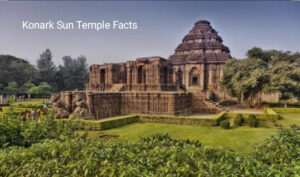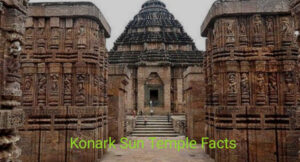The Konark Sun Temple Facts, an architectural masterpiece, stands as a testament to India’s rich cultural and historical heritage. Located in the state of Odisha, this 13th-century temple is dedicated to Surya, the Sun God. Known for its intricate carvings, grand scale, and symbolic design, the temple draws tourists and historians alike. This blog post will delve into the fascinating facts about the Konark Sun Temple, covering its historical background, architectural marvels, artistic significance, religious importance, engineering feats, conservation efforts, and practical visitor information.

1. Konark Sun Temple Facts: Historical Background
The Konark Sun Temple was constructed in the mid-13th century by King Narasimhadeva I of the Eastern Ganga Dynasty. The temple’s construction, which began around 1238 CE and took about 12 years to complete, was a demonstration of the king’s devotion to Surya and his ambition to create a monumental symbol of his reign. The temple’s architecture reflects the traditional Kalinga style, characterized by its detailed and expressive sculptures.
2. Konark Sun Temple Facts: Architectural Marvels
The temple’s unique design is one of its most striking features. Shaped like a colossal chariot, the temple is adorned with twelve pairs of intricately carved stone wheels, symbolizing the chariot of the Sun God. Each wheel is about 12 feet in diameter and is detailed with symbolic carvings representing the cycles of the seasons and the months. The temple’s facade is pulled by seven pairs of horses, capturing the dynamic movement of the Sun God’s chariot.
The Konark Sun Temple’s layout follows a precise geometric plan, aligning perfectly with the cardinal directions. The main sanctum, although now in ruins, once stood tall and was crowned with a shikara (spire) that enhanced its grandeur. The Jagamohana (audience hall) remains relatively intact, showcasing the temple’s elaborate and well-preserved sculptures.

3.Konark Sun Temple: Artistic Significance
The artistic excellence of the Konark Sun Temple is evident in its intricate carvings and sculptures. The temple walls are adorned with a plethora of motifs, including deities, celestial beings, animals, and scenes from everyday life. One of the most notable features is the depiction of the Sun God in three different forms, representing his journey across the sky: rising, noon, and setting sun.
The temple’s sculptures are not only aesthetically pleasing but also rich in symbolism. They capture the cultural and social milieu of the time, depicting scenes of courtly life, war, hunting, and various forms of dance and music. The erotic sculptures, similar to those found in the Khajuraho temples, reflect the tantric influences in temple art and the celebration of life and creation
4.Konark Sun Temple: Religious Importance
The Konark Sun Temple holds a significant place in Hindu mythology and religious practice. Dedicated to Surya, the Sun God, it was an important center for Sun worship. According to legends, Samba, the son of Lord Krishna, built the temple to honor Surya and seek his blessings for a cure from leprosy
The temple was also a major pilgrimage site, attracting devotees from far and wide. Festivals such as the annual Chandrabhaga Mela continue to draw pilgrims, who come to offer prayers and participate in rituals dedicated to the Sun God. The temple’s architectural design, aligned with the equinoxes, underscores its religious and astronomical significance.
5.Engineering Feats
The construction of the Konark Sun Temple is a marvel of medieval engineering. The temple’s alignment and design were meticulously planned to capture the first rays of the sun at dawn, which would illuminate the main sanctum. The advanced engineering techniques used in the temple’s construction are evident in the precision of the stone joints and the interlocking system of the massive stone blocks.
One of the most intriguing aspects of the temple is the theory of the ‘floating idol.’ It is believed that a powerful magnet placed at the temple’s apex held the main idol of Surya suspended in the air. Although this legend lacks concrete evidence, it adds to the temple’s mystique and engineering prowess.
6. Conservation and Restoration
Over the centuries, the Konark Sun Temple has faced numerous challenges, including natural disasters and human neglect. The main sanctum collapsed in the 19th century, likely due to structural weaknesses exacerbated by the removal of the magnetic lodestone that supposedly held the temple together.
In recent times, the Archaeological Survey of India (ASI) has undertaken extensive restoration efforts to preserve this architectural gem. The temple was declared a UNESCO World Heritage Site in 1984, highlighting its global cultural significance. Ongoing conservation work focuses on stabilizing the remaining structures, preventing further deterioration, and promoting sustainable tourism.
7.Visitor Information
The Konark Sun Temple is located about 35 kilometers from Puri and 65 kilometers from Bhubaneswar, making it easily accessible by road. The best time to visit is during the winter months, from October to March, when the weather is pleasant for sightseeing.
Visitors can explore the temple complex, which is open from sunrise to sunset. An entry fee is required, with discounts available for Indian citizens and children. Guided tours are recommended to fully appreciate the temple’s historical and artistic significance. Nearby attractions include the Chandrabhaga Beach, the Konark Museum, and the beautiful Sun Temple Garden.
8. Interesting Facts
– The Konark Sun Temple is also known as the “Black Pagoda” due to the dark color of its stones and its use as a navigational landmark by sailors.
– The temple’s wheels are not just decorative; they function as sundials, allowing visitors to tell the time based on the position of the sun.
– Legend has it that the temple was originally constructed at the mouth of the Chandrabhaga River, which has since receded, leaving the temple inland.
– The Konark Dance Festival, held annually in December, celebrates the temple’s cultural heritage with performances of classical Indian dance forms.
Conclusion:
The Konark Sun Temple stands as a magnificent testament to India’s architectural and cultural legacy. Its intricate carvings, symbolic design, and historical significance make it a must-visit for anyone interested in India’s rich heritage. Preserving such sites is crucial for future generations to appreciate and learn from our past. Whether you’re a history buff, an art lover, or a curious traveler, the Konark Sun Temple offers a glimpse into the grandeur of medieval India.
FAQ
1.What is so special about the Konark Sun Temple?
2.What are the mysterious facts about the Sun Temple?
3.What is the story behind Konark?
4.What is the science behind the Sun Temple?
5.10 facts about Konark temple
6.10 lines about Konark Sun Temple
7.Konark Sun Temple Facts for kids
8.Konark Sun Temple history
9.Scientific facts about Konark Sun Temple
10.Historical importance of Konark Sun Temple

